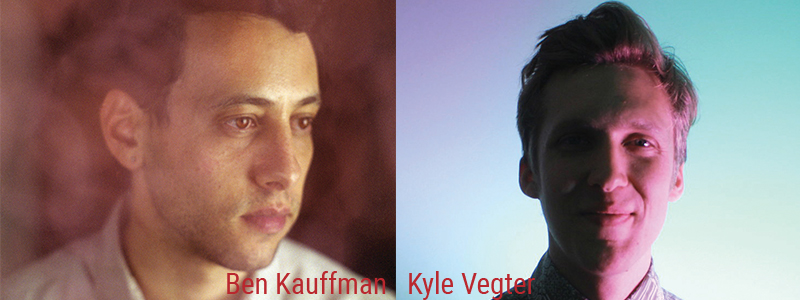The Music of Frankenstein
 We spoke with two of Manual Cinema’s Co-Artistic Directors, Ben Kauffman and Kyle Vegter, about the role of music in Frankenstein. Both Kauffman and Vegter bring considerable experience in the worlds of composition and sound design to their work with Manual Cinema, helping to immerse audiences in their storytelling with live instrumentation. Read on to learn about their approach to creating the auditory world of Frankenstein.
We spoke with two of Manual Cinema’s Co-Artistic Directors, Ben Kauffman and Kyle Vegter, about the role of music in Frankenstein. Both Kauffman and Vegter bring considerable experience in the worlds of composition and sound design to their work with Manual Cinema, helping to immerse audiences in their storytelling with live instrumentation. Read on to learn about their approach to creating the auditory world of Frankenstein.
Manual Cinema’s work is sometimes compared to silent film, a medium which heavily relied on music to complement the visuals on screen. How does music help tell the story of Frankenstein?
The music of Frankenstein supports the storytelling in a number of ways, but, maybe most importantly, the music supports the nesting-doll structure at the heart of our production (and Mary Shelley’s novel). Each story or storyteller the audience encounters during the show has its own sound universe and its own musical vocabulary. We hope this feels a little like different “narrative voices” that set apart the various stories being told. At the same time, all of the central themes and questions in the show echo and reverberate from one story to another, as if each is a dream of the others. Musically, we hope you can hear those echoes.
How do you approach composing original music for each Manual Cinema performance?
The approach is different for each project! For some productions, it’s “visuals first,” which means that the visual team creates storyboards and a rough video demo of the show, which we then score, as you would a film. Other projects are “music first,” where we write original music as the foundational element, and the visual team will create and stage the imagery in response. For Frankenstein, the novel and storyboards were the jumping-off point, so we had something text-based and visual to respond to. But some of the music was written without specific scenes in mind, more just channeling a feeling or a mood we wanted to explore.
When do you begin incorporating music into the rehearsal process? How does the score evolve as the play continues to develop?
For a new show that we’re putting up, the music team and the visual team will typically rehearse separately for a number of weeks, followed by a few weeks of full-company rehearsal. The full-company rehearsals are when we begin stitching together the visual and sonic elements of the show, and, frankly, when we first see what the show actually is. So, those full-company rehearsals are a very clarifying process. During that time, we look at the pacing of music together with visuals; we may tweak when a piece of music begins or ends, and we may even throw out music that’s not working and write something new. For Frankenstein especially, we had this question of how the staging of the musicians might create another layer of drama and storytelling for the show, and that’s the type of question that gets answered in rehearsal.
When does the creative team look to music to solve parts of the storytelling puzzle?
I feel like in our work the visual storytelling and the music/sound design work hand-in-hand pretty much non-stop. One couldn’t really function to its fullest potential without the other. Music in particular often stands in for dialogue in our work, so we might write music that expresses a character’s point of view, or illuminates the nature of a relationship that’s playing out on screen. More broadly, music and sound design really clue you in to the pacing and density of the storytelling, so it can help the creative team make decisions akin to “editing” in film parlance.
What sources of musical inspiration are you drawing from in Frankenstein?
We’re both musical omnivores and gather inspiration from a ton of different places. When we’re starting a piece we usually create a playlist of influences so that we can get on the same page before we start writing. Our Frankenstein playlist had some recent Jonny Greenwood film scores (Phantom Thread, The Master), Johan Johansson’s score for Arrival, yMusic’s new record they made with The Staves, John Adams’ The Dharma at Big Sur, Nico Muhly orchestral works, David Lang choral works, some Jenny Hval, Björk, Sufjan, Death Grips, and Flying Lotus. Harry Partch and his self-invented percussion instruments were a huge influence, especially on our use of glass instruments and the little robot arms. ■
Frankenstein is on stage November 1-December 2, 2018.
Want to be the first to see it? Dare to join us on October 31, where we’ll have a frightfully fun Halloween party followed by our final dress rehearsal.
1 response on “The Music of Frankenstein”
Comments are closed.
Can’t wait to see the show and hear the music!! Looking forward to the premier! Taking on “Frankenstein” is huge challenge!